Foundations of basic cleaning in a manufacturing facility
20.06.2019
Wetrok conducts cleaning training for Mibelle Group at their Buchs location in Canton Aargau three times a year. On the agenda for the late February training session was the basic cleaning of a manufacturing room. Cleaning personnel learned about the techniques involved in wet scrubbing, the controlled operation of a single-brush machine and how to determine pH values. The biggest learning point, however, was about something completely different.
20th February 2019, 12:00 noon: The Mibelle cleaning team enters the manufacturing room. Each person is wearing protective goggles, work coveralls and clean work shoes to ensure that no contaminants are introduced into the hygiene-sensitive production area.
Michelle Obama and apple cream
This facility and the Mibelle Biochemistry business unit usually produce ingredients for cosmetics products, which are then sold in more than 50 countries around the world. These are quite rare substances, e.g. extracts from alpine rose petals, freshwater microalgae or essences of the East Swiss apple type Uttwiler Spätlauber. These ingredients are used in a variety of creams and lotions produced by Mibelle Group and other cosmetics companies around the globe. Michelle Obama, for example, uses a skin cream containing active agents from the Uttwiler Spätlauber apple.
Two basic cleaning techniques – one alkaline, one acidic
“What kinds of contamination do we have to deal with on this floor?” is the first question posed to the nine cleaning staff by course moderator Sergio Lottenbach. The group takes a moment to analyse the tiled floor before they offer an answer: “Limescale, rust and discolouration.” Mr Lottenbach seems satisfied with the answer and informs the group about the applicable cleaning process.
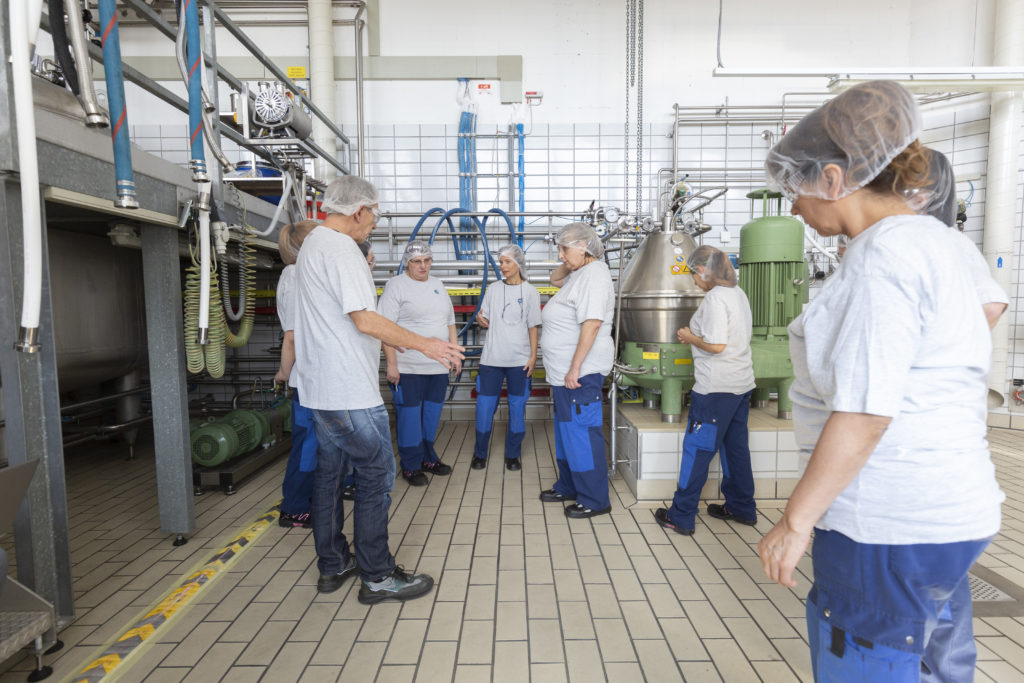
The Mibelle team will learn about two distinct types of basic cleaning today – one alkaline and one acidic technique. As a first step, an alkaline basic cleaner is used to remove all organic contaminants. Only then will they use an acidic basic cleaner to tackle limescale, rust and discolouration. “Organic contaminants such as grease form a coating over the limescale. So we always have to remove organic residue first, or we won’t be able to get to the limescale,” says the cleaning expert, explaining the reason for this two-stage approach. He asks the attendants to form two groups before they get started. Each group will be responsible for one half of the room. “Please choose a group leader. The leader will also be helping to clean, but will primarily be responsible for coordinating the work,” adds team manager Sybille Westphal. She wants to make sure that her team will immediately be able to apply the theoretical knowledge gained in the classroom that morning. The morning lessons focused on two main topics: efficient teamwork and the targeted use of open and closed questions.
Unnecessary physical exertion should be avoided
The first step of the basic cleaning process is ‘mise en place,’ i.e. collating all the materials that will be needed. The required number of mops is counted out, wet wiping equipment is put in place, cleaning buckets are prepared, single-brush machines are equipped with pads, wet vacuum cleaners and edge cleaning tools are readied. A good mise en place is a decisive factor for efficiency. The key rule here is to keep walking distances to a minimum.
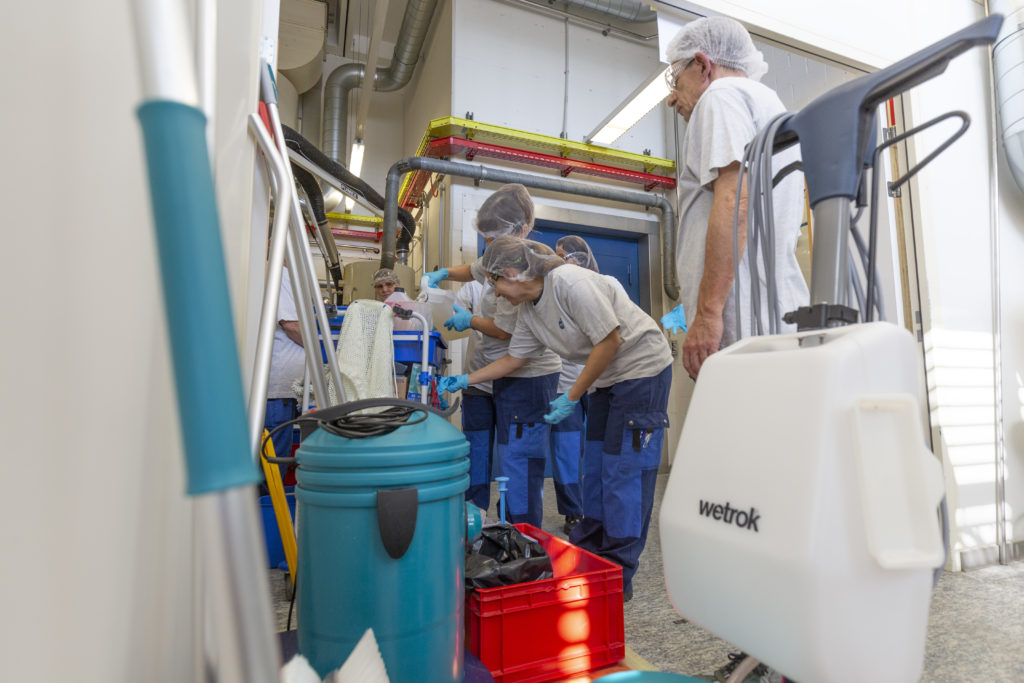
Once everyone has put on their gloves, it is time for dosing the basic cleaning product. After some discussions about the severity of soiling and the size of the room, the two group leaders decide on a mixing ratio of eight litres of water to two litres of cleaning product. “Stop! The water always goes into the bucket first and then we add the cleaning product,” one of the attendants advises her colleague, in order to prevent a mistake from being made. “Otherwise we’ll have foam everywhere!” Sybille Westphal asks the group leaders if they had thought about rinsing water. They had. Any loose dirt has already been removed, so it is now time to apply the cleaning mixture. The pre-mixed cleaning solution is poured onto the floor and distributed evenly using the mop. Good coverage of the entire floor space is essential here because otherwise, the alkaline product could leave unsightly stains. The attendants are criss-crossing the room with their mops. It all looks a little chaotic, but this team is definitely showing agility and drive. The Wetrok specialist spots one woman who has started working on a section of floor with a grout brush. “Never mind the brush,” he says. “We won’t use a brush to spread the cleaning solution. That takes much too much energy and it is much easier with the mop,” he explains.
Circular motions with a single-brush machine
After a short contact time of ten minutes, it is time to use the single-brush machine. One group follows the advice of the course moderator and decides to use a microfibre pad. The other group uses a brush. The floor is then cleaned bit by bit using circular motions. Streams of dark brown, almost black water are flowing towards the floor drain. The alkaline product is making the floor very slippery, which makes things very challenging for the personnel. Safely operating the single-brush machine is the main skill required for this work step. One of the attendees is having a very hard time keeping her balance. Sybille Westphal spots the problem right away and knows when she is needed. She rushes over to the woman, stands behind her to offer more stability, while she too holds on to the handle of the single-brush machine. Meanwhile, some other women have picked up an edge cleaning tool to finish off the areas of floor that the machine cannot reach. The team spirit of this group is very evident. Two colleagues are always at hand when the pad or brush needs rinsing during the cleaning process – another example of efficient teamwork. Now it is time to exchange the single-brush machine for the wet vacuum cleaner so that any residual waste water can be removed from the floor, one strip at a time.
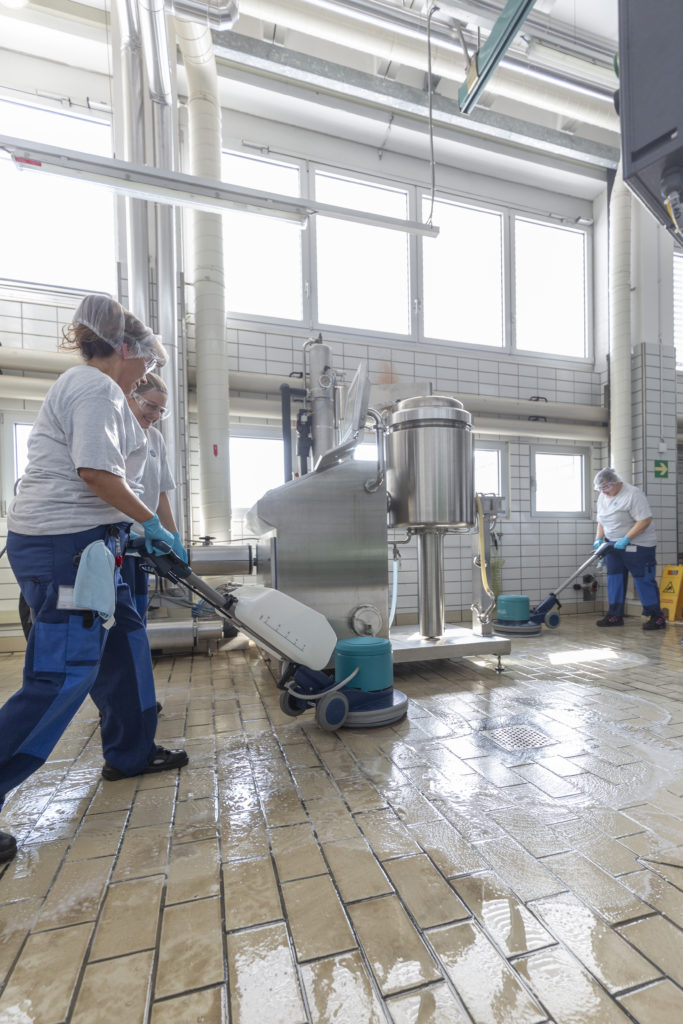
Small pH strip – big efficiency gain
Now comes the final work step: rinsing. One group carries out the rinsing process using a mop and water bucket, the other decides to use the single-brush machine with a water tank. The floor needs two rinses because of the strong foaming effect of the cleaning product. The wet vacuuming step is then repeated. Now for the moment of truth: A pH test will show whether the floor is back in the neutral range (a pH value between 7 and 8). If it is not, the teams won’t be able to move on to the acidic basic cleaning process. They would have to rinse the floor again first. The group leader takes a pH strip, moistens it with fresh water and places it on the cleaned floor for a few seconds. The test is repeated in a second location to be absolutely certain. And voilà! The pH value is in the neutral range. While the group using a mechanical approach (single-brush machine) have achieved a perfect pH value of 7, the group using a manual approach (mop) have a value between 7 and 8. “This test is not just about safety, it is also about efficiency: You’ll no longer have to rinse five times to make sure the floor is back in the neutral pH range. Just rinse twice and then do the test – you might find that additional rinses would have been superfluous. This approach can save huge amounts of time,” says Sybille Westphal, summarising the benefit of this control tool.
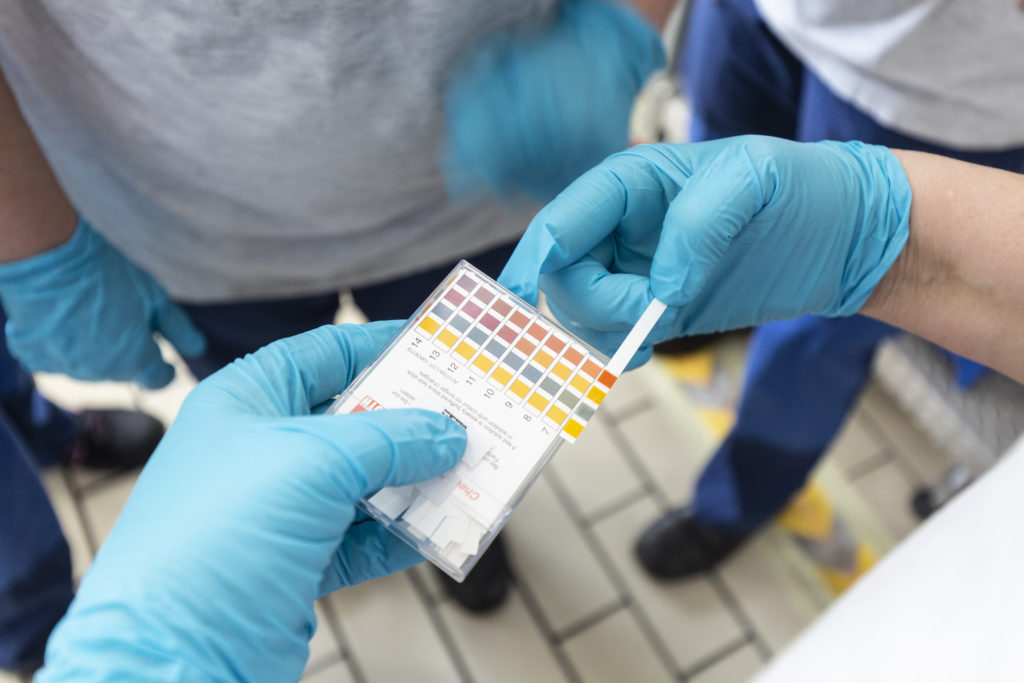
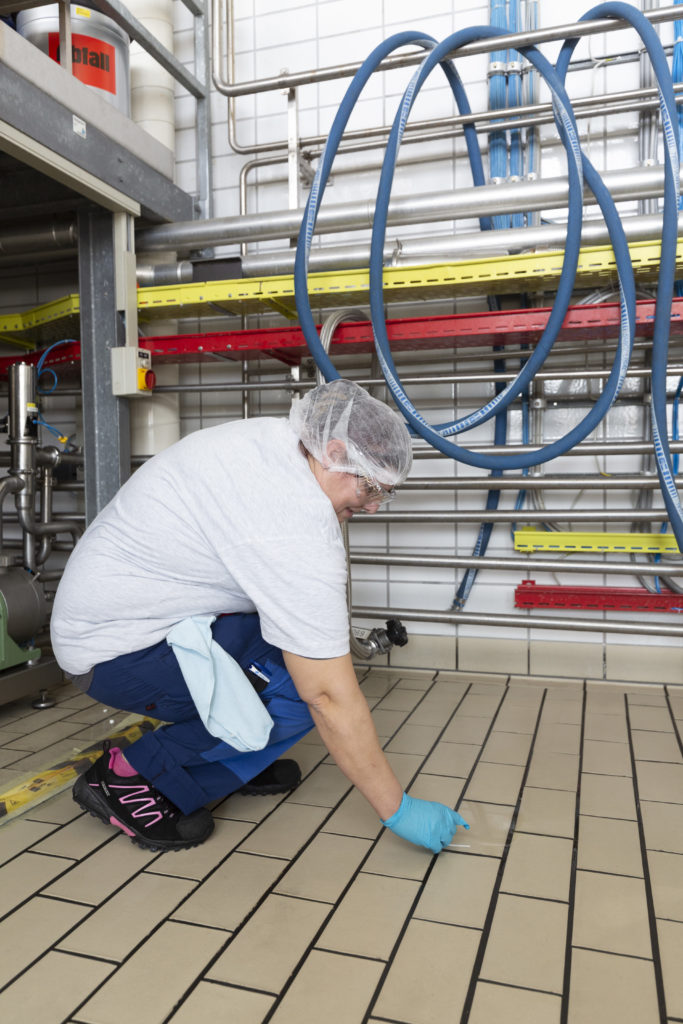
Communication is key
Another important step after performing such a comprehensive workflow is, of course, feedback. So everyone who participated in the training session gathers in the middle of the now squeaky clean room. The Wetrok course moderator praises everyone’s active participation: “Each one of you gave your best and the way you supported each other was exemplary. This vigour, however, did result in some chaos from time to time. You will have to think about and internalise the logic of each of the work steps a little more,” he adds. He gives them food for thought by offering a few examples: They should really leave the floor alone during contact time because it is too soon to start working with the edge cleaning tool or a grout brush during that time. And the grout cleaning tool should not be used on any areas where the single-brush machine has not yet finished its work. It should instead be used on strips that the machine has already passed over. “It won’t mean that the job is done any more quickly – you’ll just be tired faster,” he explains, pointing back to the morning’s theory lesson about efficiency. The faces around him are grinning in agreement. Sybille Westphal also has something to add: “Don’t underestimate the importance of communication. Some of the mistakes made today could have been prevented by simply asking questions. For next time, I am hoping that each group leader will be more aware of their role as coordinator and communicator in the team,” she adds. There are nods all around, indicating that the attendees have already identified the ways in which they can optimise their work. This capacity for reflection in particular makes it very clear that these employees aren’t just ‘cleaners’ – they are competent cleaning professionals.
Key points for acidic cleaning
The floor still needs to be freed of limescale, which means the cleaning process begins again from the start. This time, however, an acidic cleaning product is used. Now is the perfect opportunity for attendees to address the room for improvement identified during the first round. “Does the acid also need contact time?” asks one of the course participants, addressing Sergio Lottenbach directly. “Absolutely! In fact, it is very important and it will enable you to remove all traces of the limescale. It is just like when you descale a coffee machine – when you do that, you leave the descaler to do its job for a few minutes as well,” he replies, using one of the kitchen analogies that he is so fond of. He explains that the process is the same as the basic cleaning with the alkaline cleaning product but that before acid cleaning commences, it is very important that the grout is thoroughly moistened with water. He emphasises how important it is that the pads, buckets and the wet vacuum cleaner are thoroughly rinsed to avoid a chemical reaction when the acidic basic cleaner is added. If in doubt, the pH test can also be used on the equipment.
Customised training as a team building event
It is a joy to watch the team during the second basic cleaning process: No edge cleaning tools are used prematurely. There are no misunderstandings but more questions are asked. Clear answers and instructions are given to clarify every team member’s role. The effect can be seen clearly in the time needed for cleaning: The second round is done in nearly half the time of the first round. Sybille Westphal is proud of her group and believes firmly in the concept of customised training: “It is absolutely amazing to see what all of us here have achieved together in a single day. Half a day of theory and have a day practical training have given us education and a team building event all in one. We have seen today that it isn’t the expert knowledge of the individual that makes us successful as a team – it is the way we communicate with each other.”
The 11 steps of the basic cleaning process:
- Remove any loose dirt (dust-binding mopping)
- Mix the cleaning solution in the bucket at the correct ratio
- Moisten the grout
- Apply cleaning solution to the floor using a mop
- Allow a contact time of 10 to 15 minutes for the cleaning solution
- Perform wet scrubbing using a single-brush machine with a pad/brush
- Use an edge cleaning tool and grout brush to clean edges and grout
- Use the wet vacuum cleaner to remove waste water
- Rinse the area with water
- Use the wet vacuum cleaner to remove residual moisture
- Check the pH value of the cleaned area (repeat the rinsing process as needed)
Short interview with Sybille Westphal, Head of Cleaning and Garment Management at Mibelle Group’s Buchs facility
“People listen in a different way when an external trainer comes to teach”
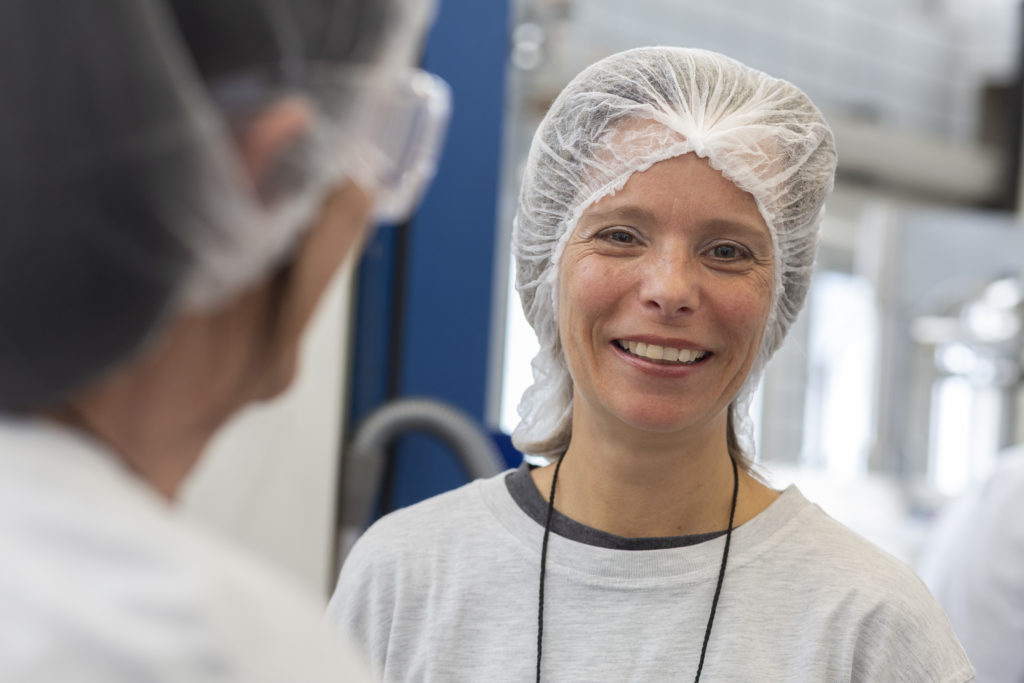
You are a cleaning specialist with many years of experience, but you still have an external company coming in to train your team – why is that?
For my colleagues, hearing me give instructions and tips on how to improve is an everyday experience. To really learn something new, it is important that you break free from the patterns of familiarity. By bringing in external cleaning professionals, I can ensure that the new content from the sessions is regarded as important and is committed to memory more thoroughly. People listen in a different way when an external trainer comes to teach. For example: Some time ago, we purchased microfibre pads for cleaning processes with the single-brush machine but until now, my team hadn’t been very enthusiastic about them. As part of today’s training, however, the Wetrok trainer convinced the team on the basis of his own experiences that a microfibre pad can be very useful for basic cleaning. An external perspective can sometimes change everything.
Why are you holding the team training sessions in actual work environments?
Previously, our employees attended various cleaning courses held at the company location of the training provider. There were two decisive drawbacks to this: First of all, not all employees were able to attend the same courses and secondly, they weren’t able to work with the materials they were accustomed to. Now we only send new employees to these kinds of standardised cleaning courses. Instead, we organise customised training with a Wetrok course moderator at our own facility three times a year. That way, our employees can work with the equipment, machines and products they actually use in their everyday work environment. And the training involves the type of floor coverings we clean on a regular basis. Another advantage of customised training is that I can choose the course content that is currently needed.
What progress have you seen in your team as a result of the customised training?
The greatest potential for improvement is not usually in the area of professional know-how of a cleaning squad or team, but instead in their communication and teamwork. Cleaning personnel in large companies usually work on their own. Most of the day, they are deployed individually to various areas of the premises. To ensure that things run smoothly, especially when staff are covering for other colleagues due to annual leave or sickness, good communication is vital. It is exactly what employees should be learning about – in theoretical teaching sessions about team building models and the subsequent opportunities to implement this in practice. Improved communication capabilities will allow the team to work more autonomously because individuals will be able to help each other out when difficulties arise, without having to consult me on everything. I am so proud of the great progress we have made in that area already – and I’m sure it will only get better from here.
